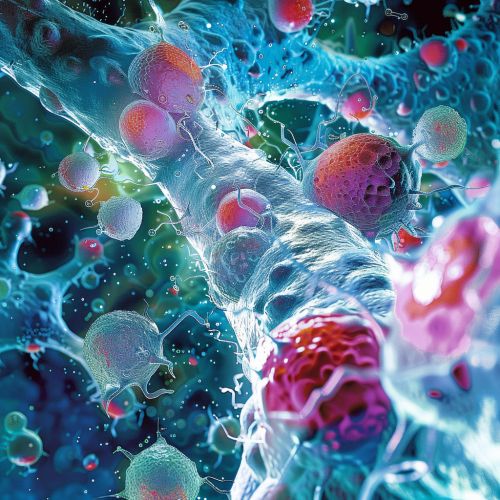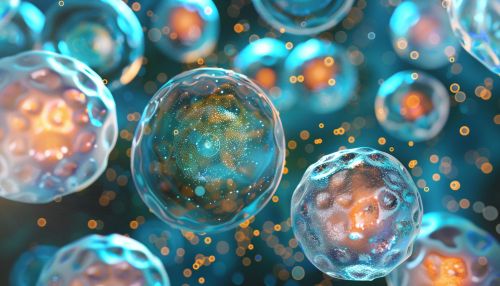Cell Communication
Introduction
Cell communication is a fundamental process that governs the activities and interactions of cells within multicellular organisms. This intricate system of signaling allows cells to coordinate their functions, respond to environmental changes, and maintain homeostasis. Understanding cell communication is essential for comprehending various biological processes, including development, immune responses, and disease mechanisms.
Types of Cell Communication
Cell communication can be broadly categorized into several types based on the distance over which the signaling occurs and the nature of the signaling molecules involved.
Autocrine Signaling
In autocrine signaling, cells release signaling molecules that bind to receptors on their own surface, leading to a response within the same cell. This type of signaling is crucial for self-regulation and feedback mechanisms. For example, certain growth factors can act in an autocrine manner to regulate cell proliferation.
Paracrine Signaling
Paracrine signaling involves the release of signaling molecules by a cell that affect nearby target cells. This local signaling is essential for processes such as tissue repair and inflammation. An example of paracrine signaling is the release of cytokines by immune cells, which influence the behavior of neighboring cells.
Endocrine Signaling
Endocrine signaling involves the secretion of hormones into the bloodstream, allowing them to travel long distances to reach target cells throughout the body. This type of signaling is vital for maintaining physiological balance and regulating functions such as metabolism, growth, and reproduction. Insulin is a classic example of an endocrine hormone that regulates blood glucose levels.
Juxtacrine Signaling
Juxtacrine signaling occurs when signaling molecules remain attached to the surface of the signaling cell and interact directly with receptors on adjacent cells. This type of signaling is important in processes like cell differentiation and tissue organization. An example is the interaction between Notch receptors and their ligands, which plays a critical role in cell fate determination.
Synaptic Signaling
Synaptic signaling is a specialized form of communication used by neurons. It involves the release of neurotransmitters across a synapse to transmit signals to another neuron or effector cell. This type of signaling is essential for the functioning of the nervous system. Acetylcholine is a neurotransmitter that mediates synaptic signaling at neuromuscular junctions.
Signaling Molecules
Signaling molecules, also known as ligands, are diverse in structure and function. They include proteins, peptides, amino acids, nucleotides, steroids, and gases.
Protein and Peptide Ligands
Protein and peptide ligands, such as growth factors, hormones, and cytokines, play crucial roles in cell communication. These molecules often bind to cell surface receptors, triggering intracellular signaling cascades.
Steroid Hormones
Steroid hormones, such as estrogen and testosterone, are lipid-soluble molecules that can diffuse through cell membranes and bind to intracellular receptors. These hormones regulate gene expression and are involved in processes like development and metabolism.
Amino Acid-Derived Molecules
Amino acid-derived molecules, including epinephrine and dopamine, function as neurotransmitters and hormones. They are critical for the regulation of physiological responses such as stress and mood.
Gaseous Signaling Molecules
Gaseous signaling molecules like nitric oxide (NO) and carbon monoxide (CO) can diffuse across cell membranes and modulate various cellular functions. NO, for example, is involved in vasodilation and neurotransmission.
Receptors
Receptors are proteins that bind to signaling molecules and initiate cellular responses. They can be classified based on their location and mechanism of action.
Cell Surface Receptors
Cell surface receptors are embedded in the plasma membrane and interact with extracellular ligands. They include:
G-Protein-Coupled Receptors (GPCRs)
GPCRs are a large family of receptors that activate intracellular G-proteins upon ligand binding. This activation triggers various signaling pathways, influencing processes such as sensory perception and immune responses.
Receptor Tyrosine Kinases (RTKs)
RTKs are receptors that possess intrinsic kinase activity. Ligand binding induces receptor dimerization and autophosphorylation, leading to the activation of downstream signaling cascades. Epidermal growth factor receptor (EGFR) is an example of an RTK involved in cell growth and differentiation.
Ion Channel Receptors
Ion channel receptors, also known as ligand-gated ion channels, open or close in response to ligand binding, allowing ions to flow across the membrane. This type of receptor is crucial for rapid signaling in neurons and muscle cells. The nicotinic acetylcholine receptor is an example of an ion channel receptor.
Intracellular Receptors
Intracellular receptors are located within the cell and bind to lipid-soluble ligands that can cross the plasma membrane. These receptors often function as transcription factors, directly influencing gene expression. Glucocorticoid receptors are intracellular receptors that regulate the expression of genes involved in stress responses.
Signal Transduction Pathways
Signal transduction pathways are the series of molecular events that transmit signals from receptors to target molecules within the cell. These pathways often involve multiple steps and components, including second messengers, kinases, and transcription factors.
Second Messengers
Second messengers are small molecules that relay signals from receptors to target molecules within the cell. Common second messengers include cyclic AMP (cAMP), calcium ions (Ca2+), and inositol trisphosphate (IP3). These molecules amplify the signal and activate downstream effectors.
Kinase Cascades
Kinase cascades involve a series of phosphorylation events mediated by protein kinases. These cascades amplify and propagate the signal, ultimately leading to cellular responses. The mitogen-activated protein kinase (MAPK) pathway is a well-known kinase cascade involved in cell proliferation and differentiation.
Transcription Factors
Transcription factors are proteins that regulate gene expression by binding to specific DNA sequences. They are often the final targets of signal transduction pathways and play a crucial role in translating extracellular signals into cellular responses. NF-κB is a transcription factor involved in immune and inflammatory responses.
Cellular Responses
Cellular responses to signaling can vary widely depending on the cell type, the nature of the signal, and the context in which it is received. These responses include changes in gene expression, alterations in cell metabolism, and modifications in cell behavior.
Gene Expression
One of the primary outcomes of cell signaling is the regulation of gene expression. Signaling pathways can activate or repress the transcription of specific genes, leading to changes in protein synthesis and cellular function. For example, the activation of the JAK-STAT pathway by cytokines results in the transcription of genes involved in immune responses.
Metabolic Changes
Cell signaling can also induce metabolic changes to meet the energy demands of the cell or to adapt to environmental conditions. The activation of AMP-activated protein kinase (AMPK) in response to low energy levels leads to the upregulation of catabolic pathways and the downregulation of anabolic pathways.
Cell Proliferation and Differentiation
Signaling pathways play a critical role in regulating cell proliferation and differentiation. Growth factors and hormones can stimulate cell division, while other signals can induce cells to differentiate into specialized cell types. The Wnt signaling pathway is involved in both cell proliferation and differentiation during development.
Apoptosis
Apoptosis, or programmed cell death, is a tightly regulated process that eliminates damaged or unnecessary cells. Signaling pathways can trigger apoptosis in response to various stimuli, such as DNA damage or infection. The caspase family of proteases plays a central role in the execution of apoptosis.
Dysregulation of Cell Communication
Dysregulation of cell communication can lead to various diseases, including cancer, autoimmune disorders, and neurodegenerative diseases. Understanding the mechanisms underlying these dysregulations is crucial for developing targeted therapies.
Cancer
In cancer, aberrant signaling pathways can lead to uncontrolled cell proliferation and survival. Mutations in genes encoding signaling proteins, such as Ras and PI3K, are common in many cancers. Targeted therapies, such as tyrosine kinase inhibitors, aim to disrupt these dysregulated pathways.
Autoimmune Disorders
Autoimmune disorders arise when the immune system mistakenly attacks the body's own cells. Dysregulation of immune signaling pathways, such as those involving T cells and B cells, can contribute to the development of autoimmune diseases like rheumatoid arthritis and multiple sclerosis.
Neurodegenerative Diseases
Neurodegenerative diseases, such as Alzheimer's disease and Parkinson's disease, are associated with the dysregulation of neuronal signaling pathways. Abnormal protein aggregation and impaired neurotransmission are key features of these diseases. Research into the signaling mechanisms involved is ongoing to identify potential therapeutic targets.


Conclusion
Cell communication is a complex and essential process that enables cells to coordinate their activities and respond to their environment. The diverse mechanisms of cell signaling, from autocrine to synaptic, and the intricate pathways involved highlight the sophistication of cellular interactions. Understanding these processes at a detailed level provides insights into normal physiology and the pathogenesis of various diseases, paving the way for the development of novel therapeutic strategies.
